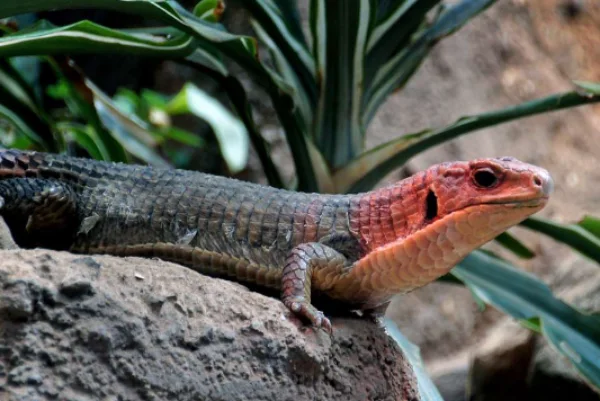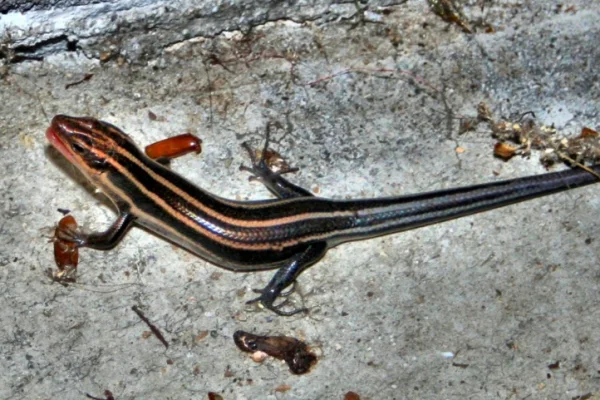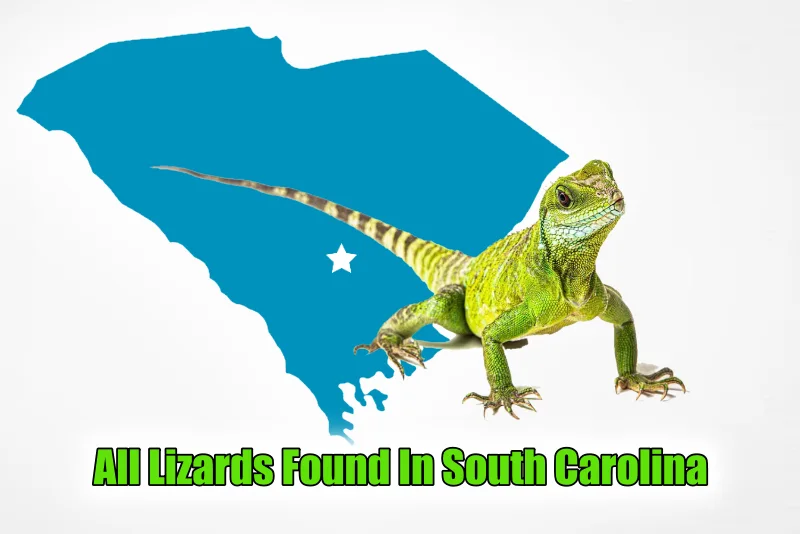Lizards are the most common reptile on earth and are mostly found in every region of the world. Some are as big as alligators, like comodo dragons, and some are tiny, like rats. When I was looking for some of the lizards, I came across a region where many lizards are found, and the lizards are really beautiful and cute.
Here we are going to look at lizards that are found in South Carolina. There are a total of 12 native species of lizards in South Carolina according to “Wildlife Information – SC Lizards – SCDNR.”
Other species have recently been introduced to the region, or, we can say, are making South Carolina their new home. Moreover, here we are going to look at 12 lizards that are native to South Carolina and what kind of habitat they like to live in.
Let’s begin!
All Lizards Found In South Carolina
1. Broad-headed skink

| Scientific name | Plestiodon laticeps |
| Type of lizard | Skink |
| Size | 15-33 cm |
| Identification | Broad orange head |
| Habitat | Open forests |
The first species we are going to look at is the broad-headed skink. This is a species of lizard found in South Carolina and the southeastern United States. They are known for their triangular heads and wide jaws.
Commonly, adult males are brown or olive brown and have bright orange heads during spring mating. While females have five light stripes and blue tails, they also have five labial scales around the mouth.
2. Mimic glass lizards
| Scientific name | Ophisaurus mimicus |
| Type of lizard | Glass lizards |
| Size | 38-65 cm |
| Identification | Three to four dark strips |
| Habitat | Open woodlands |
The mimic glass slender is another species of glass lizard, but unlike other glass lizards, it is small. Talking about its presence, this lizard, which is found in South Carolina, is brown with three to four dark stripes running through its body.
This species has a dark brown to black color. You can easily encounter this species in open woodlands like longleaf pine forests. It feeds on invertebrates.
3. Coal skink

| Scientific name | Plestiodon anthracinus |
| Type of lizard | Skink |
| Size | 13-18 cm |
| Identification | black strip at the sides |
| Habitat | Humid woodlands with abundant leaves and stones |
The next coal skink or lizard is also found in South Carolina. This species can grow 13–18 cm in length. Talking about its identification, you can identify this lizard through its broad-fark lateral stripes with some lines on the top.
4. Green anole
| Scientific name | Anolis carolinensis |
| Type of lizard | Anole |
| Size | 12.5-20.3 cm |
| Identification | Green body with pink throat |
| Habitat | The region has high humidity, including forests, grasslands, and swamps. |
The green anole is a medium-sized lizard that can change color from dark brown to vibrant green depending on environmental conditions.
The majority of their diet is small invertebrates, consumed by birds, snakes, amphibians, spiders, and small mammals.
Males are highly territorial during warmer months and display their pink dewlap to ward off rivals or court females.
5. Island glass lizards
| Scientific name | Ophisaurus compressus |
| Type of lizard | Glass lizards |
| Size | Approx. 60 cm |
| Identification | Slightly narrow head |
| Habitat | Sandy scrub and sea islands |
Like other glass lizards, the Island glass lizards also had long, slender bodies. Also, they didn’t have limbs. You can see this lizard in a range of colors, from brown to tan, with strips. You can identify this lizard by its narrow head, which is elongated compared to other species.
They like to live in the region of sandy scrub and sea islands. This species of lizard is found rarely in South Carolina. Island glass lizards mostly feed on small invertebrates.
6. Slender glass lizard
| Scientific name | Ophisaurus attenuatus |
| Type of lizard | Glass lizards |
| Size | 56-106 cm |
| Identification | Pointy snout |
| Habitat | Fields, woodland, and near water |
The slender glass lizards are scientifically known as Ophisaurus attenuatus. The species has a long, slender body with smooth scales. Talking about its color, this lizard can be found in yellow- to brown-colored varieties.
It has been observed that this lizard can grow up to 56–106 cm. It has a very tiny body, which makes it look similar to collard lizards. You can identify slender glass lizards by their pointy snout, and they have eyelids and ears.
7. Ground skink
| Scientific name | Scincella lateralis |
| Type of lizard | Skink |
| Size | 7-9 cm |
| Identification | Copper brown color |
| Habitat | Near streams and ponds |
Ground skinks, also known as little brown skinks and scientifically known as Scincella lateralis, are small, dark-brown skinks or lizards found in South Carolina. Its slender body weaves in and out of leaves, searching for insects and spiders.
The lizard is abundant in habitats with leaf litter and rarely climbs. It is one of the smallest reptiles, having a total length of 3–5.5 inches. Its back is coppery brown with a white or yellow underside.
8. Eastern glass lizards
| Scientific name | Ophisaurus ventralis |
| Type of lizard | Glass lizard |
| Size | 45–107 cm |
| Identification | dark strips |
| Habitat | Sandy habitats |
Another lizard native to South Carolina is the eastern glass lizard; they are smooth, slender, and have smooth scales on their whole body. You can find them in various color variations, from tan to green.
These are the longest lizards found in South Carolina. Most of these lizards feed on amphibians, invertebrates, and other reptiles. They have white marks around their necks.
9. Six-line racerunner
| Scientific name | Aspidoscelis sexlineata |
| Type of lizard | Race runners |
| Size | 15–24 cm |
| Identification | Blue underside |
| Habitat | hot, dry, and open habitats |
This lizard is a small to medium-sized lizard with a black body with yellow stripes and a rough underside. They can grow up to 15–24 cm in length.
It is active in hot, dry, open habitats like fields, sand barrens, coastal dunes, and forest edges. They have longer tails than other lizards.
10. Southeastern five-lined skink
| Scientific name | Plestiodon inexpectatus |
| Type of lizard | Skink |
| Size | 12-21 cm |
| Identification | Five strips at the back with a red-orange head |
| Habitat | Dry environment |
The Southeastern Five-Lined Skink is a medium-sized lizard with smooth, shiny scales, varying in appearance depending on age and gender. Adults are light to dark brown with five faint stripes and an average length of 5–8.5 inches.
Found in woodland habitats like sandhills, pine forests, and maritime forests, they prefer drier environments and eat various invertebrates.
11. Eastern fence lizard
| Scientific name | Sceloporus undulatus |
| Type of lizard | Spiny-horned lizards |
| Size | 10-19 cm |
| Identification | iridescent blue color on the sides |
| Habitat | Dry and open woodland |
The Eastern Fence Lizard is a small brown or gray lizard with large, overlapping scales on its body. Males are darker brown and have iridescent blue on their belly and throat during breeding season. Females are grayish and have dark, wavy patterns on their backs.
12. Common five-lined skink
| Scientific name | Plestiodon fasciatus |
| Type of lizard | Skink |
| Size | 12-21 cm |
| Identification | Five orange lines |
| Habitat | Steep, rocky area |
This medium-sized lizard has smooth, shiny scales and varies in coloration and pattern depending on age and gender. Its average adult length is 5–8.5 inches, with males generally larger.
During the breeding season, male heads change to a reddish-orange. The lizard has four labial scales, two post-labials, and an enlarged middle row of scales on the ventral side of the tail.
2 Lizards Not Native But Introduced:
Here we are going to discover 2 species of lizards that are available in large numbers but not native. These are the 2 lizards species you can find easily in whole South Carolina but they are not the inhabitants rather than introduced.
1. Mediterranean House Gecko
| Scientific name | Hemidactylus turcicus |
| Type of lizard | Gecko |
| Size | 3-6 cm |
| Identification | two color camouflage |
| Habitat | rock crevices or cracked tree trunks |
This small lizard, 1.5 to 2.5 inches long, has vertical pupils and large, round eyes. It has two color phases for camouflage: pale phase, light pink to pale yellow or white with brown or gray blotches, and dark phase, dark gray or brown, obscuring blotches on the back. It has a big head, large pupils, no eyelids, a stout tail, and large toe pads.
2. Brown anole
| Scientific name | Anolis sagrei |
| Type of lizard | Anole |
| Size | 12-20 cm |
| Identification | lines on its back and a dewlap |
| Habitat | like to live in open fields and sherbs |
The brown anole is a light brown lizard with darker brown to black markings on its back and tan to light color lines on its sides. It can change color and has a dewlap ranging from yellow to orange-red. Brown anoles are typically 5.0 to 8.5 inches long and can grow as large as their male counterparts. Female brown anoles are similar in size to their male Carolina counterparts, but have a smaller head. Female anolis lizards exhibit heritable polymorphism in their dorsal patterning.
Conclusion:
Here, we take a rest for today. These are some of the lizards native to South Carolina. Some of these lizards are spread all around the southeastern United States. Do you know South Carolina has the largest number of lizards?
Lizards like the green anole and broad-headed skink are some of the lizards you can find in the dry and humid areas of South Carolina. Hopefully, you find this information helpful. Keep looking for some more facts about the animal kingdom on HowItSee.
Frequently Asked Questions:
Q1. What are the most common lizards in South Carolina?
Ans. Lizards like Green anole, Slender glass lizards, Broadhead skink, and many more are the most common lizards in South Carolina.
Q2. Are there any poisonous lizards in South Carolina?
Ans. No, there are no poisonous lizards in South Carolina.
Q3. What are the little lizards in South Carolina?
Ans. Ground skinks also known as little brown skinks are the little lizards in South Carolina.
Q4. What is the largest lizard in South Carolina?
Ans. Black and white tegu is the largest lizard in South Carolina.
Q5. What are the two most poisonous lizards?
Ans. The Gila monster and the Mexican beaded lizard are the two most poisonous lizards.
Q6. What are the most aggressive lizards?
Ans. Komodo dragons, Tegu, and Gila monsters are the most aggressive lizards.
Q7. What do South Carolina lizards eat?
Ans. South Carolina lizards eat a wide variety of insects.
Q8. Do scorpions live in South Carolina?
Ans. Yes, there are scorpions like southern unstriped scorpions in South Carolina.
Q9. Are there big snakes in South Carolina?
Ans. Eastern Diamond-backed Rattlesnakes and Timber rattlesnakes are the big snakes in South Carolina.
Q10. Does South Carolina have snakes?
Ans. Yes, there are around 38 species of Snakes in South Carolina.
Q11. What is the average lifespan of lizards found in South Carolina?
Ans: The average lifespan of lizards in South Carolina can vary depending on the species. Generally, smaller species like ground skinks may live for 2-3 years, while larger species like green anoles can live for 4-6 years in the wild.
Q12. How do lizards in South Carolina survive during the winter months?
Ans: Lizards in South Carolina employ various survival strategies during the winter months. Some species, like green anoles, may become dormant or hibernate in sheltered areas to conserve energy, while others, like broad-headed skinks, may seek refuge in burrows or under leaf litter to avoid extreme cold temperatures.
Q13. Are there any conservation efforts in place to protect lizards in South Carolina?
Ans: Yes, there are conservation efforts in place to protect lizards and their habitats in South Carolina. Organizations like the South Carolina Department of Natural Resources (SCDNR) work to monitor lizard populations, preserve habitats, and educate the public about the importance of lizard conservation.
Q14. Can lizards found in South Carolina be kept as pets?
Ans: Some species of lizards found in South Carolina, like green anoles and brown anoles, are commonly kept as pets. However, it’s essential to research and understand the specific care requirements of each species before keeping them as pets. Additionally, it’s illegal to capture and keep native wild lizards as pets without proper permits in South Carolina.
Q15. How do lizards contribute to the ecosystem in South Carolina?
Ans: Lizards play essential roles in the ecosystem of South Carolina. They help control insect populations by feeding on pests like mosquitoes, ants, and flies, which helps maintain ecological balance. Additionally, lizards serve as prey for various predators, including birds of prey and snakes, contributing to the overall biodiversity of the region.
Reference
- Wikipedia
- https://scparc.org/lizards-of-south-carolina/
- https://www.dnr.sc.gov/wildlife/herps/lizards.html
Also Read:

As a content writer, I like to write about different niches. I have a curiosity about nature and animals. And like to learn about them. Through my writing, I like to share my experience and knowledge with you. I hope you are enjoying it too.
